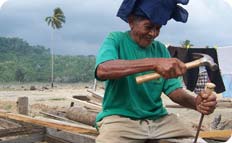Related projects
Related resources
- ProVention-ALNAP publication: Responding to earthquakes 2008 - Learning from earthquake relief and recovery operations
- ProVention-ALNAP publication: Flood disasters: Learning from previous relief and recovery operations
- ProVention-ALNAP publication: Slow-onset disasters: drought and food and livelihoods insecurity – Learning from previous relief and recovery responses
- IFRC study: Rebuilding after Hurricane Mitch: Housing reconstruction in Honduras and Nicaragua
- IFRC study: Community participation in rebuilding in the Maldives
- IFRC study: Supporting communities to rebuild in Sri Lanka
- More resources...
 |
|
Reducing Risks in Recovery |

From recovery to long-term risk reduction
While post-disaster recovery has frequently been treated as a separate phase distinct from both emergency relief and long-term development, there is increasing recognition that these activities are often integrally related, especially from the perspective of reducing risk and vulnerability. Ultimately the implementation of effective risk reduction measures is necessarily a critical aspect of sustainable development, just as relief and recovery activities must start with protecting vulnerable people from further risks. However despite the hyperbole, there are real questions about the extent to which recovery does indeed offer a ‘window of opportunity’ for long-term risk reduction.
Recognising the increased needs for and attention to recovery, heightened considerably after the 2004 tsunami, as well as the many actors already working across the broad spectrum of recovery and reconstruction, ProVention has focused its recovery agenda on the specific issue of strengthening the links from recovery to risk reduction.
Lessons learned
A key point of departure has been the wide dissemination during 2005 of the results of the set of Recovery Lessons Learned studies which address system-wide policy and practice issues to be considered in recovery planning and operations. These case studies identify lessons learned from the following disasters:
- Bangladesh (floods 1998)
- Honduras (Hurricane Mitch 1998)
- India (Gujarat earthquake 2001)
- Mozambique (floods 2000 and 2001)
- Turkey (earthquakes 1999).
ProVention continues to promote and disseminate the results of these studies which address system-wide policy and practice issues to be considered in recovery planning and operations.
Seeking also to make these lessons more readily available during critical relief and early recovery activities, ProVention has collaborated with the Active Learning Network for Accountability and Performance in Humanitarian Action (ALNAP) to draw together past lessons as a guide for ongoing response planning and extend analysis of risk reduction in broader recovery evaluations.
Building on these studies, ProVention has also evaluated how these types of lessons learned are currently being applied, or not, to reduce risks. In this regard, ProVention’s interest in recovery seeks to better ground the conventional wisdom that recovery automatically represents a ‘window of opportunity’ for risk reduction by developing and promoting tools for better assessing, designing and implementing such opportunistic strategies as well as analysing the obstacles for linking risk recovery to risk reduction. This theme was also picked up in the ProVention Forum in 2006 as captured in a background paper [PDF, 0.4MB] by Ian Christoplos.
Key areas of interest for further studies include the impact of recovery on strengthening livelihoods and reducing vulnerability, use of microinsurance for providing risk transfer mechanisms particularly to the poor, cost-benefit analyses of the net benefits and effectiveness of risk reduction measures, and the social and political contexts and policy environments that enable (or hinder) the implementation of effective risk reduction measures.
In addition, ProVention seeks to disseminate and integrate other ProVention resources, such as the mainstreaming tools, GRIP information and data, community risk assessment methodologies and risk transfer mechanisms, all of which are extremely relevant to the recovery process.
ProVention has also given particular attention to shelter and related issues of reconstruction policy and settlement planning with a view to better understanding the longer-term performance of shelter solutions in enabling effective disaster risk reduction. This links closely to ProVention’s concern to promote the reconstruction of resilient critical infrastructure, taking forward ProVention’s ongoing collaboration with OAS and PAHO on safe schools and safe health facilities.
In October 2005 ProVention partnered with the IFRC to support the development of the Temporary Shelter Action Plan for Aceh and Nias in Indonesia as part of the ongoing recovery efforts from the Indian Ocean tsunami.
ProVention’s active participation in the International Recovery Platform is also considered a key opportunity for knowledge sharing and partnering risk reduction learning for recovery.